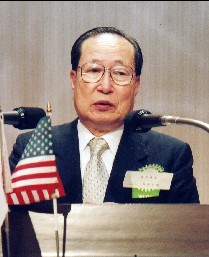��The Marchant��s Business Styles and Lives in Edo (1600-1866)��
February 25 th, 2004
Mr. Tsunehiko Yui
Head of the Mitsui Library,
and Chairman of the Japan Management
History Research Institute
 Mr. Tsunehiko Yui, Head of the Mitsui Library, and Chairman of the Japan Management History Research Institute spoke at the meeting of February 25 on ��The Marchant��s Business Styles and Lives in Edo (1600-1866)��.
Mr. Tsunehiko Yui, Head of the Mitsui Library, and Chairman of the Japan Management History Research Institute spoke at the meeting of February 25 on ��The Marchant��s Business Styles and Lives in Edo (1600-1866)��.
Many believe that Japan��s modernization was very much behind that of England and other Western countries, but by the 18th century Edo was then the largest city in the world. Most of the inhabitants were consumers making it the largest consumer city. At the time, London��s population was half a million, so Edo was the world��s largest city in terms of population and consumption.
It was a time when the cities of Osaka, Kyoto and Edo developed, and the Tokaido highway connecting these cities was 450 or so kilometers with 53 overnight stations. There were inns, medical clinics, stables, and messengers available at these stations, so a well equipped traffic and travel system had been established. There are no other such examples in world history, and the highway had a great cultural and economic significance.
Freight was not moved overland, but mainly by sea. A regular sailing schedule was established between Edo and Osaka, and recent studies show that the sailing schedules were tightly kept. There were tramp cargo vessels, and risk was scattered as a form of insurance. Rice, rice wine, and other bulk materials were shipped safely from port to port.
Mail was also looked after. It took a week by messenger, and with a runner, only 3 days for mail to reach between Edo and Osaka. The fact that the western postal system was so easily introduced into Japan was that it had already been in place. By 1887 it covered Japan almost entirely. Thus the idea of an infra-structure and system had already taken root in the Edo period.
A system of transactions had developed in Osaka some 300 years ago, and rice futures were traded. This system which had become quite popular, was carried over into modern Japan where it quickly modernized.
The Mitsui Echigo-ya is a kimono merchant which became the Mitsukoshi Department Store of today. It occupied 1,000 tsubo (1 tsubo=0.3025 sq. m) and there were 1,000 workers. There were no stores of such magnitude in the world at the time. From the 18th to the beginning of the 19th century it was the world��s largest retail shop. From its inception 330 years ago, it was reknown for its fixed price system.
Although it is the same nowadays, credit was extended to important customers, but otherwise it operated on a cash-and-carry system. There are no such examples in the world at the time. Fittings could be done on the spot with also an easy-order system. All sizes were available, and it is clear that the business was built on very modern business practices. The clerks were also quite well trained.
At first, boys of 12 to 13 years were hired as helpers, and at 17 or 18 became clerks, then by 25 or 26 became managers. After serving well for some years they are allowed to keep-their own households. Then at 45 or 46 they retired from the first line, but kept in the employ or became independent.
If they passed away during employment, their funeral and grave were looked after by the Mitsui family which example cannot be found elsewhere.
The store would start at daybreak, and it was the helpers who cleaned and scrubbed the premises, and it was quite a job to clean several hundred ashtray.
The store closed relatively early, and then in the evening, the helpers were made to study while the clerks went to the communal bath and then practiced whatever form of singing they liked. In October, their teacher would be invited and a recital would take place. In November everyone would be invited to see a Kabuki performance, and in January a bonus would be given.
There were festivals every month. There were also periodical health checks, with those ill being sent to hot springs for recuperation. Those who have served for a long period were given vacations so they could return home. In December, all would gather unneeded clothes to give to the poor.
Thus, little was wasted, and it was the same with all the families in Edo, where a system of recycling had been established.